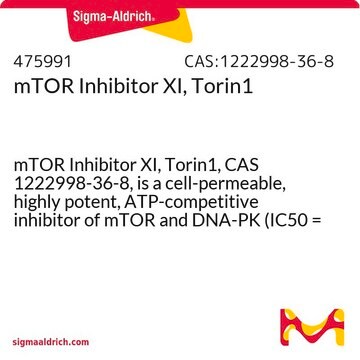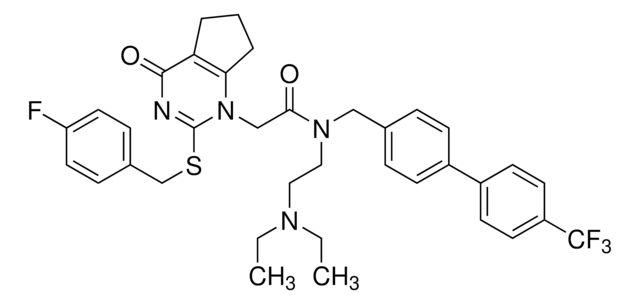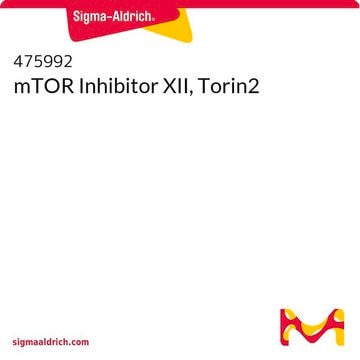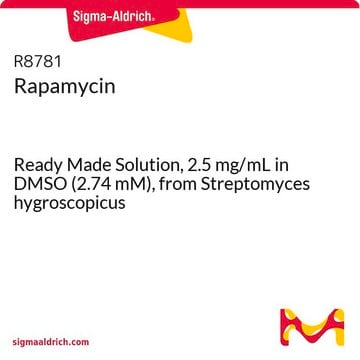ABE2889M
Anti-phospho 4E-BP1 (Ser83)
Synonym(e):
Eukaryotic translation initiation factor 4E-binding protein 1, eIF4E-binding protein 1, Phosphorylated heat- and acid-stable protein regulated by insulin 1, PHAS-I
About This Item
Empfohlene Produkte
Biologische Quelle
rabbit
Qualitätsniveau
Antikörperform
serum
Antikörper-Produkttyp
primary antibodies
Klon
polyclonal
Speziesreaktivität
human
Methode(n)
flow cytometry: suitable
immunocytochemistry: suitable
immunofluorescence: suitable
western blot: suitable
Isotyp
IgG
NCBI-Hinterlegungsnummer
UniProt-Hinterlegungsnummer
Versandbedingung
ambient
Posttranslationale Modifikation Target
phosphorylation (pSer73)
Angaben zum Gen
human ... EIF4EBP1(1978)
Allgemeine Beschreibung
Spezifität
Immunogen
Anwendung
Flow Cytometry Analysis: A representative lot detected phospho 4E-BP1 (Ser83) in Nocodazole-arrested HeLa cells (Velasquez, C., et. al. (2016). Proc Natl Acad Sci USA. 113(30):8466-71).
Immunocytochemistry Analysis: A representative lot detected phospho 4E-BP1 (Ser83) in HEK293 and U2OS cells (Velasquez, C., et. al. (2016). Proc Natl Acad Sci USA. 113(30):8466-71).
Western Blotting Analysis: A representative lot detected phospho 4E-BP1 (Ser83) in Nocodazole-arrested HeLa cells, GST-4E-BP1 treated with mitotic HeLa lysate (Velasquez, C., et. al. (2016). Proc Natl Acad Sci USA. 113(30):8466-71).
Western Blotting Analysis: A representative lot detected phospho 4E-BP1 (Ser83) in Hela cells treated with Nocodazole (Courtesy of Dr. Yuan Chang at University of Pittsburgh).
Immunofluorescence Analysis: A 1:500 dilution from a representative lot detected phospho 4E-BP1 (Ser83) in FFPE MCC tissue (Courtesy of Dr. Yuan Chang at University of Pittsburgh).
Epigenetics & Nuclear Function
Qualität
Western Blotting Analysis: A 1:1,000 dilution of this antibody detected phospho 4E-BP1 (Ser83) in lysate from HeLa cells treated with Nocodazole (100 ng/mL).
Zielbeschreibung
Physikalische Form
Lagerung und Haltbarkeit
Handling Recommendations: Upon receipt and prior to removing the cap, centrifuge the vial and gently mix the solution. Aliquot into microcentrifuge tubes and store at -20°C. Avoid repeated freeze/thaw cycles, which may damage IgG and affect product performance.
Sonstige Hinweise
Haftungsausschluss
Sie haben nicht das passende Produkt gefunden?
Probieren Sie unser Produkt-Auswahlhilfe. aus.
Lagerklassenschlüssel
12 - Non Combustible Liquids
WGK
WGK 1
Flammpunkt (°F)
Not applicable
Flammpunkt (°C)
Not applicable
Analysenzertifikate (COA)
Suchen Sie nach Analysenzertifikate (COA), indem Sie die Lot-/Chargennummer des Produkts eingeben. Lot- und Chargennummern sind auf dem Produktetikett hinter den Wörtern ‘Lot’ oder ‘Batch’ (Lot oder Charge) zu finden.
Besitzen Sie dieses Produkt bereits?
In der Dokumentenbibliothek finden Sie die Dokumentation zu den Produkten, die Sie kürzlich erworben haben.
Active Filters
Unser Team von Wissenschaftlern verfügt über Erfahrung in allen Forschungsbereichen einschließlich Life Science, Materialwissenschaften, chemischer Synthese, Chromatographie, Analytik und vielen mehr..
Setzen Sie sich mit dem technischen Dienst in Verbindung.








